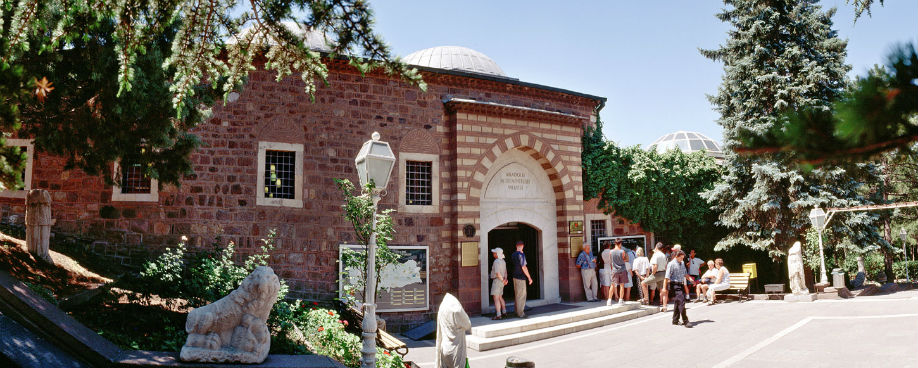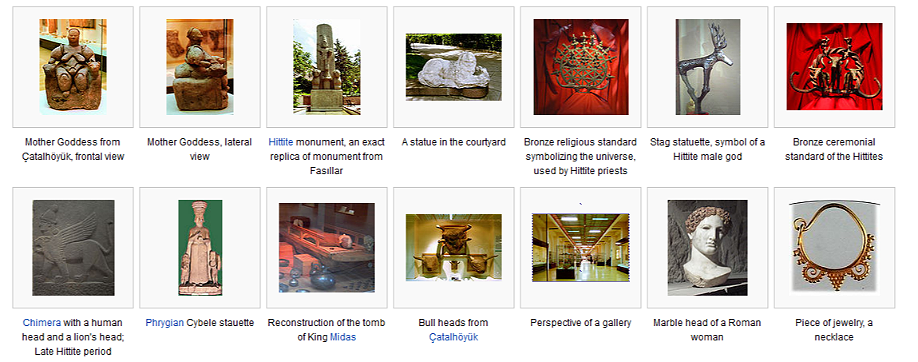The superb Museum of Anatolian Civilisations is the perfect introduction to the complex weave of Turkey’s ancient past, housing artefacts cherry-picked from just about every significant archaeological site in Anatolia.
The museum is housed in a beautifully restored 15th-century bedesten (covered market). The 10-domed central marketplace houses reliefs and statues, while the surrounding hall displays exhibits from the earlier Anatolian civilisations: Palaeolithic, Neolithic, Chalcolithic, Bronze Age, Assyrian, Hittite, Phrygian, Urartian and Lydian. The downstairs sections hold classical Greek and Roman artefacts and a display on Ankara’s history. Get there early to avoid the flood of tour groups and school parties.
The exhibits are chronologically arranged in a spiral: start at the Palaeolithic and Neolithic displays in the room to the right of the entrance, then continue in an anticlockwise direction, visiting the central room last.
Items from one of the most important Neolithic sites in the world Çatalhöyük, southeast of Konya – are displayed here. There’s a mock-up of the inside of a dwelling typical of those uncovered at the site, one of the most famous mother goddess sculptures unearthed from the excavations and wall paintings of hunting scenes.
Also on show are many finds from the Assyrian trading colony Kültepe, one of the world’s oldest and wealthiest bazaars. These include baked-clay tablets found at the site, which dates to the beginning of the 2nd millenium BC.
One of the striking Hittite figures of bulls and stags in the next room used to be the emblem of Ankara. The Hittites were known for their relief work, and some mighty slabs representing the best pieces found in the country, generally from around Hattuşa, are on display in the museum’s central room.
Most of the finds from the Phrygian capital Gordion, including incredible inlaid wooden furniture, are on display in the museum’s last rooms. The exhibits also include limestone blocks with still-indecipherable inscriptions resembling the Greek alphabet, and lion- and ram-head ritual vessels that show the high quality of Phrygian metalwork.
Urartian artifacts are also on display here. Spurred by rich metal deposits, the Urartians were Anatolia’s foremost metalworkers, as the knives, horse-bit, votive plates and shields on display demonstrate. There are also terracotta figures of gods in human form, some revealing their divine powers by growing scorpion tails, and neo-Hittite artefacts.
Downstairs, classical-period finds and regional history displays provide a local picture. Excavations have unearthed a Roman road near the Column of Julian, and Ankara has its own ‘missing link’, the 9.8-million-year-old Ankarapithecus (a 30kg, fruit-eating primate).




This is maybe one of the greatest museums of the world. Good thing about it is that it is small, items on display is limited. They don't display all they have but best of all. The chronological display helps unfold history.
This is an excellent collection and a wonderful building. Unfortunately it was being renovated in-part when I visited and my trip was marred by the attendant who tried to short change me when I paid for my entrance ticket. I hired the headphones for a self tour but the recording was out of date. Press '**' for a description of…
I was especially impressed with the number of well preserved Hittite artefacts – jewellery I could wear today and bowls I could put on my table.
Not very big (one part was out of order due the reconstruction), but with full with museum pieces..
You will only have about 30 minutes here, but it is a treasure trove of Hittite and early Anatolian civilizations. There are also the gold jewelry items from Troy that have been returned to Turkey by Germany.
still it is the best museum option in ankara since it is in renovation most parts has been closed till 2013(thats what museum staff says lest make it 2014) but even for its open parts you may spend at least 3 hours for it(if you like to read all descriptions you may spend up to 5 hours for it). after…
When I visited this museum in the late 1990's I thought it was the best museum I had ever seen. I enjoyed it this time too, but so much was missing because of the restorations. I found the Hittite sculpture awesome.
With its nice garden, built in an ancient covered market lasts from Ottoman Empire era. It is a well organized small museum that you can find many interesting artefacts on the displays; remaining from numerous civilizations that ruled in Anatolia.
The Ankara Anatolian Civilizations Museum is definitely one of the museums one has to see. Unfortunately, at the moment only 2 parts of 5 in total are open for visitors. That was more than enough to enjoy the exhibits from the Hitities period and lots of small objects from various civilizations in the region.
This Museum is one of the best museums in Turkey. Please reserve at least 3 to four hours to understand a lşt bit of people who lived in Anatolia.